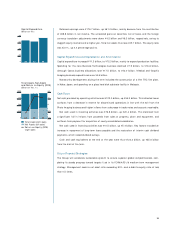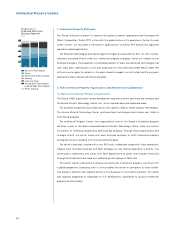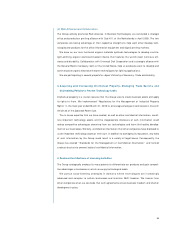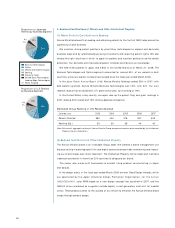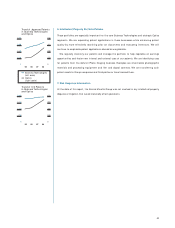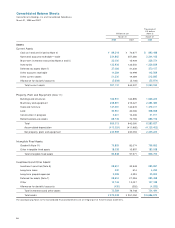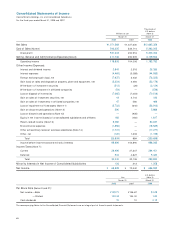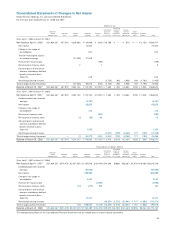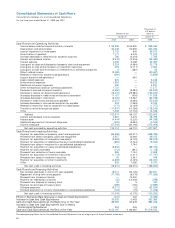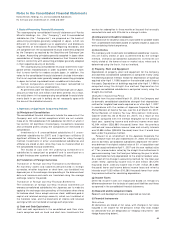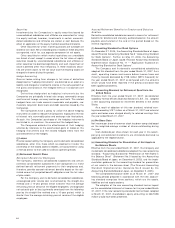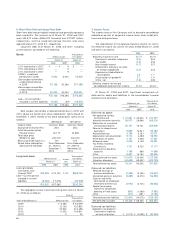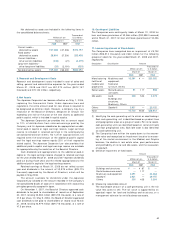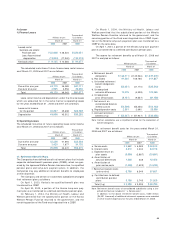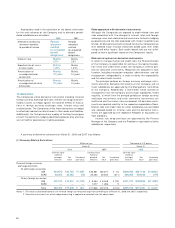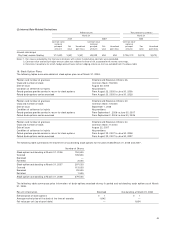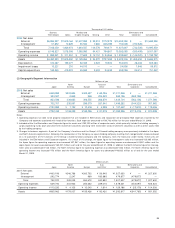Konica Minolta 2008 Annual Report Download - page 46
Download and view the complete annual report
Please find page 46 of the 2008 Konica Minolta annual report below. You can navigate through the pages in the report by either clicking on the pages listed below, or by using the keyword search tool below to find specific information within the annual report.43
Notes to the Consolidated Financial Statements
Konica Minolta Holdings, Inc. and Consolidated Subsidiaries
For the fiscal years ended March 31, 2008 and 2007
1. Basis of Presenting Financial Statements
The accompanying consolidated financial statements of Konica
Minolta Holdings, Inc., (the “ Company” ) and its consolidated
subsidiaries (the “ Companies” ) are prepared on the basis of
accounting principles generally accepted in Japan, which are
different in certain respects as to application and disclosure
requirements of International Financial Reporting Standards, and
are compiled from the consolidated financial statements prepared
by the Company as required by the Securities and Exchange Law
of Japan. Accounting principles generally accepted in Japan allow
consolidation of foreign subsidiaries based on their financial state-
ments in conformity with accounting principles generally accepted
in their respective country of domicile.
The accompanying consolidated financial statements incor-
porate certain reclassifications in order to present them in a form
that is more familiar to readers outside Japan. In addition, the
notes to the consolidated financial statements include information
that is not required under generally accepted accounting principles
in Japan, but which is provided herein as additional information.
Certain comparative amounts have been reclassified to
conform to the current year classifications.
As permitted under the Securities and Exchange Law of Japan,
amounts of less than one million have been omitted. As a result,
the totals shown in the accompanying consolidated financial state-
ments (both in yen and in dollars) do not necessarily agree with
the sums of the individual amounts.
2. Summary of Significant Accounting Policies
(a) Principles of Consolidation
The consolidated financial statements include the accounts of the
Company and, with certain exceptions which are not material,
those of its 108 subsidiaries (120 subsidiaries for 2007) in which it
has control. All significant intercompany transactions, balances
and unrealized profits among the Companies are eliminated on
consolidation.
Investments in 8 unconsolidated subsidiaries (10 uncon-
solidated subsidiaries for 2007) and 3 significant affiliates (3
significant affiliates for 2007) are accounted for using the equity
method. Investments in other unconsolidated subsidiaries and
affiliates are stated at cost, since they have no material effect on
the consolidated financial statements.
The excess of cost over the underlying investments in
subsidiaries is recognized as goodwill and is amortized on a
straight-line basis over a period not exceeding 20 years.
(b) Translation of Foreign Currencies
Translation of Foreign Currency Transactions and Balances
All monetary assets and liabilities denominated in foreign
currencies, whether long-term or short-term, are translated into
Japanese yen at the exchange rates prevailing at the balance sheet
date and revenues and costs are translated using the average
exchange rates for the period.
Translation of Foreign Currency Financial Statements
The translation of foreign currency financial statements of
overseas consolidated subsidiaries into Japanese yen is made by
applying the exchange rates prevailing at the balance sheet dates
for balance sheet items, except common stock, additional paid-in
capital and retained earnings accounts, which are translated at
the historical rates, and the statements of income and retained
earnings which are translated at average exchange rates.
(c) Cash and Cash Equivalents
Cash and cash equivalents in the consolidated cash flow state-
ments comprises cash on hand and short-term investments that
are due for redemption in three months or less and that are easily
converted into cash with little risk to a change in value.
(d) Allowance for Doubtful Accounts
The allowance for doubtful accounts is provided for possible losses
from uncollectible receivables based on specific doubtful accounts
and considering historic experience.
(e) Inventories
The Company and its domestic consolidated subsidiaries’ invento-
ries are mainly stated at cost as determined by the average
method. Overseas consolidated subsidiaries’ inventories are
mainly stated at the lower of cost or market value, where cost is
determined using the first-in, first-out method.
(f) Property, Plant and Equipment
Depreciation of property, plant and equipment for the Company
and domestic consolidated subsidiaries is computed mainly using
the declining balance method, except for depreciation of buildings
acquired after April 1, 1998, based on the estimated useful lives of
the assets. Depreciation of buildings acquired after April 1, 1998 is
computed using the straight-line method. Depreciation for
overseas consolidated subsidiaries is computed mainly using the
straight-line method.
Changes in Accounting Policy
Effective from the year ended March 31, 2008, the Company and
its domestic consolidated subsidiaries changed their depreciation
method for tangible fixed assets acquired on or after April 1, 2007
in accordance with the revision of Japanese Corporate Tax Law
(Partial Revision of Income Tax Law, Law No. 6 of March 30, 2007;
Partial Revision of Income Tax Law Enforcement Ordinance,
Cabinet Order No. 83 of March 30, 2007). As a result of this
change, compared with the method employed for the previous
fiscal year, operating income and ordinary income were each
¥2,894 million ($28,885 thousand) lower than the previous
method and income before income taxes and minority interests
was ¥2,886 million ($28,805 thousand) lower than it would have
been under the previous method.
Pursuant to an amendment to the Japanese Corporate Tax
Law, effective from the year ended March 31, 2008, the Company
and its domestic consolidated subsidiaries depreciate the differ-
ence between the original residual value of 5% of acquisition cost
of assets acquired before April 1, 2007 and the new residual value
of 1 Yen (memorandum value) by the straight line method over 5
years commencing from the fiscal year following the year in which
the asset becomes fully depreciated to the original residual value.
As a result of this change in accounting method, for the fiscal year
under review, operating income was ¥1,240 million ($12,376
thousand) lower, ordinary income was ¥1,241 million ($12,386
thousand) lower and income before income taxes and minority
interests was ¥1,030 million ($10,280 thousand) lower than under
the previous method for calculating depreciation.
(g) Income Taxes
Deferred income taxes are recognized based on temporary
differences between the tax basis of assets and liabilities and those
as reported in the consolidated financial statements.
(h) Research and Development Costs
Research and development costs are expensed as incurred.
(i) Financial Instruments
Derivatives
All derivatives are stated at fair value, with changes in fair value
included in net income for the period in which they arise, except
for derivatives that are designated as “ hedging instruments” (see
Hedge Accounting below).


